anthropic principle
advertisement
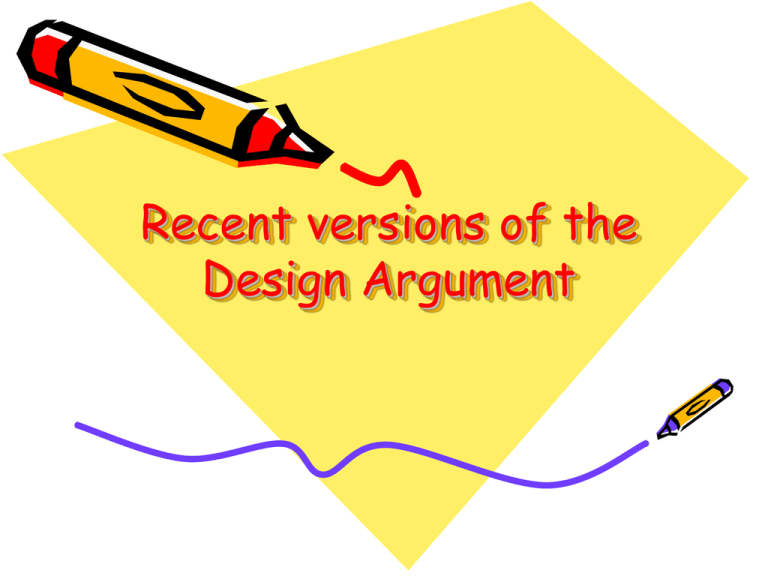
Recent versions of the Design Argument Outline the Design Argument. The Goldilocks Theory • Just as Goldilocks found the porridge that was just right, the Earth seems to be just right for living creatures. The Earth seems to be the perfect distance from the sun for lots of water. • Venus is too close to the sun, and too hot for flowing water on its surface. In fact, it is so hot that, like a sauna, all the water has been evaporated into the atmosphere, and Venus has a thick and heavy atmosphere. • Mars is too far from the sun, and too cold for flowing water on its surface. Mars also has no continental drift, so particles of the atmosphere which become trapped within the ground stay trapped within the ground. Thus over time the atmosphere of Mars has become thin, and all the water is frozen into the ground. • The temperature of Earth is just right for flowing water on the surface, and for the rock which allows for continental drift. With continental drift, particles of the atmosphere which become trapped within the ground are brought back to the atmosphere through eruptions of volcanoes. • These conditions cause refreshment of the planet's atmosphere. A medium sized atmosphere helps keep temperatures just right for flowing water (through the greenhouse effect). These conditions are just right for abundant life. Answer the question below • How does the Goldilocks theory support the idea of intelligent design? • Discuss this in your groups and write a suitable answer Recent contributors • F R Tennant – The Anthropic Principle – The Aesthetic Principle • Richard Swinburne – The argument from Probability Anthropic Principle • Developed by F R Tennant in his book Philosophical Theology (1930). • Argument claims that the universe has been designed for the ultimate purpose of producing intelligent life. • This argument takes the view that “random chance” is not a sufficient or realistic explanation for the way the universe is fine tuned to produce human life. Anthropic Principle • The Big Bang – The strength of the Big Bang was just enough to create the conditions for the galaxies to form and life on earth to develop. Had the strength of the Big Bang been slightly bigger or slightly weaker, then the galaxies would not have been formed and the earth would not have developed. Had there been even a slight variance in the basic elements emerging from the Big Bang we would not be here today. Anthropic Principle • How do you feel about the Anthropic Principle at this point? • Do you agree or disagree with the idea that because certain conditions had to be present for human life to develop, that this could only occur if it had been planned? Anthropic Principle • Tennant believed that there were three types of natural evidence in the world that suggested the existence of a designer God: – The fact that the world can be analysed in a rational way (in other words, intelligent being can detect the workings of an intelligent mind). – The way in which the inorganic world has provided the basic necessities required to sustain life (e.g. trees producing oxygen). – The progress of evolution towards the emergence of intelligent human life (evolution is seen as God’s way of creating intelligent human life). Anthropic Principle Summary • Tennant argued that it would be impossible to imagine a chaotic universe where no rules or laws applied. • However, the universe is not chaotic. • The evidence suggests that the universe is a result of careful design, planned in such a way that would allow for the evolutionary process to occur and create an environment in which intelligent life could exist. • According to Tennant, human life is the culmination of God’s plan. Who else might be able to contribute to this discussion? • Polkinghorne – Argued that the unlikelihood of human life being the result of blind chance gives no rise to “considerations which theism provides a persuasive answer”. – What do you think this means? – He is not saying that the way in which the universe has produced human life proves that there is a designer God but he is saying that this would be a rational and credible conclusion to draw. – This is very similar to Swinburne’s argument from probability which we will deal with shortly. Aesthetic Argument • An argument also develop by F R Tennant to prove the existence of God. • The aesthetic argument was developed in response to the challenge that evolutionary theory presented to Christian ideas about creation. • Evolutionary theory argued that the creatures in the world were as they were, not because they had been designed that way, but because, through natural selection, they had adapted to the demands of their environment. Aesthetic Argument • Tennant’s aesthetic argument claimed that humans possess an ability t appreciate the beauty of their surroundings – for example, they can enjoy art, music, literature and culture. • This appreciation of beauty – the ‘aesthetic sense’ of humans – is not necessary for the survival or development of human life and so cannot be a result of natural selection. • The aesthetic sense of humans therefore provides evidence of a divine creator. Aesthetic Argument How do you feel about the Aesthetic Argument at this point? Anthropic Principle and the Aesthetic Argument In pairs make a note of any possible criticisms you can make of Tennant’s arguments. Argument from Probability • Developed by Richard Swinburne in his book The Existence of God (1979). • Put forwards a version of the design argument that is based on probability • Observed that the order in the universe and the way that it provides the conditions necessary for life and concludes that an intelligent designer is the best, or most probable, explanation that we have. Argument from Probability Key Points of Swinburne’s argument: • There is universal orderliness in the universe. All the bodies in the universe conform to the same, simple scientific laws. • The existence of this orderliness and uniform natural laws has provided the conditions necessary for human life to develop. – Furthermore, this is a providential world; one which contains everything necessary for human survival, and one in which humans can meaningfully contribute to its development and maintenance, within the limitations of its naturals laws Argument from Probability Key Points of Swinburne’s argument continued…: • The universe could just as easily have been chaotic. The fact that it is not suggests that it was designed for the purpose of human life to develop – it did not just occur by random chance. – An intelligently designed universe cannot be proved, but it is more probable that the natural laws were designed than that they happened by chance. • Since there is design, God is the simplest explanation for the universe. – Belief in God makes better sense of all the evidence that we have available than any other alternative. Whilst a purposeful designer cannot be proved to exist, it is more plausible and satisfactory explanation than not. Argument from Probability In pairs discuss what, if anything is wrong with Swinburne’s argument. Paley (1743-1805) suggested that you should imagine walking across open countryside with some friends and suddenly coming across a watch hidden amongst the grass. You pick up the watch and are so impressed by its craftwork that you ask your friends: “Who do you think made this?” Now imagine, said Will, that one of your friends replies: “Nobody actually made this watch. It has always existed and has always been there.” If a friend were to give you this sort of reply, said Will, you would naturally be entitled to think that he/she had not seen the object clearly or that he/she had but were not wired up properly. Personally I’d then slap them with a wet fish! According to Paley the reason is obvious. The watch simply shows too much evidence of DESIGN and PURPOSE for nobody to have been responsible for its existence. Read Paley’s Natural Theology to find out more! There is then, said Will, only one possible sensible answer to the question “Who do you think made this?” and that is to give the name of a person who has a skilled designing mind. We reach this conclusion because if any object shows evidence of DESIGN and PURPOSE then the inference is inevitable – that must be There is then, said Will, only one sensible answer that can be given to the question a maker. “WHO or WHAT made the Universe?” and Paley continued his argument by saying that is to say that because it shows so that if it is nonsense to say that a watch much evidence of DESIGN and came about by chance or has always PURPOSE it must therefore has been existed then it is equally nonsensical to designed by a designer i.e. GOD. say that the ‘Universe’ came about by chance or has always existed. He argued 1) Explain in your own words how that the ‘Universe’ (like the watch) shows William Paley uses the DESIGN evidence of too much complicated and PURPOSE of a watch to try DESIGN and PURPOSE for that to be the to prove the existence of GOD. case. 2) Do you agree with Paley’s argument? Give reasons for your answer. Perhaps you could discuss: Consider the complicated body-designs of animals, birds and fish. Think how each is so perfectly designed for life on the land, sea and air. Or consider the DESIGN of your own eyes, ears and nose and how once again they are each so perfectly designed to fulfil the PURPOSE of seeing, hearing and smelling. (a) Is Paley right to compare a watch to the Universe? (b) Has Paley made it clear what the PURPOSE of the Universe is (as he did with the watch)? If William Paley has managed to prove that GOD exists there should be no way of looking at the evidence and coming to any other conclusion. Many people, however, say that this is just not the case. In fact, you can look at Paley’s evidence and come to the conclusion that GOD doesn’t exist. You could agree with Will that the Universe contains ORDER and that this order is necessary for life to begin and survive. HOWEVER, you do not have to agree that the ORDER was designed by a designing mind called GOD. You could say that this ORDER is simply the product of chance. Imagine being given two dice and told to keep throwing these dice until all the possible combinations of numbers come up. Sooner or later (given enough time) you will achieve this task. What is being said is that NATURE is playing a similar game. Instead of throwing dice it is throwing atoms around and because it has INFINITE-TIME to play then these atom will sooner or later go through all their possible combinations. The order that you see then in the Universe is not designed-order; it is simply he result of one of Nature’s many throws with the atoms. The ORDER is simply the result of chance and not a DESIGNING GOD. These people then do not agree that William Paley has ‘proved’ that GOD exists. They say hat his evidence is AMBIGUOUS. You can look at it and sensibly come to the conclusion that either God exists or that He doesn’t exist. The question of whether or not there is a DRIVER guiding the ‘journey of life’ must remain an open question! 1) Many people believe that the Universe contains order. They do not necessarily believe that this order was designed by GOD. Explain how they think this order came about. 2) It is possible that GOD did design the Universe and also possible that He didn’t. Which do you believe is probable? Give reasons.
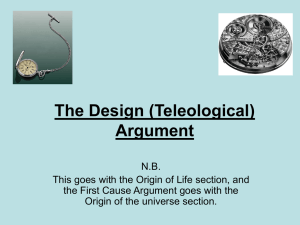
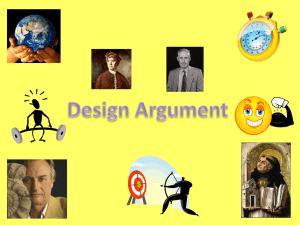

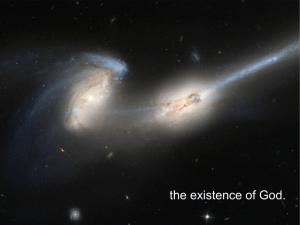


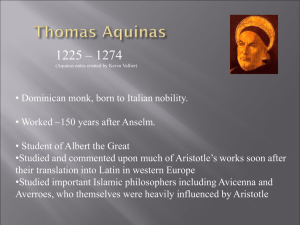

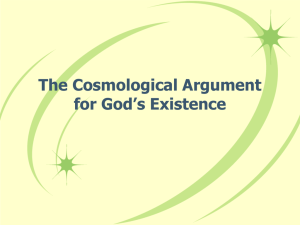
![Student Resource Sheet 3[LA]: Anthropic Arguments](http://s3.studylib.net/store/data/007328335_1-62024b5821d7739ef5907c8f45a8dd1d-300x300.png)